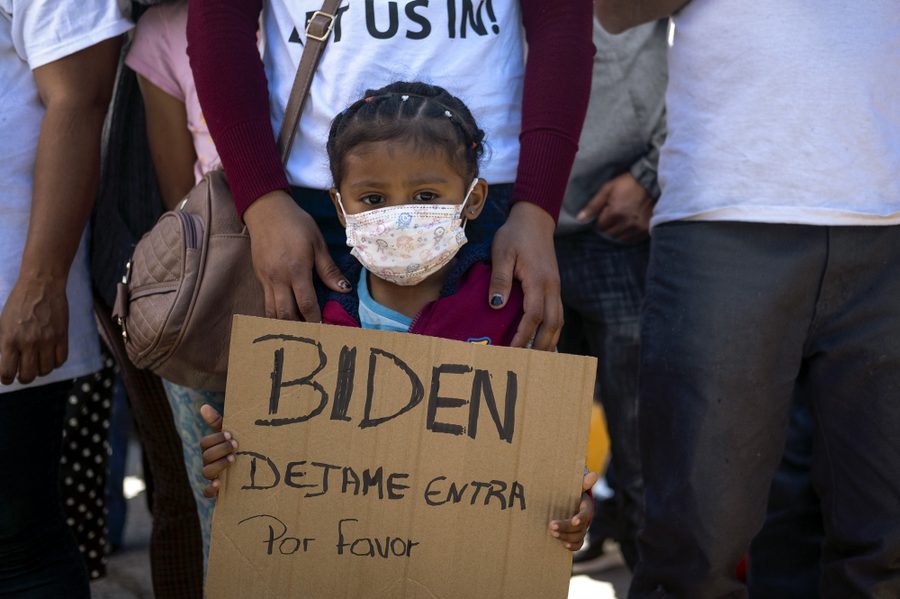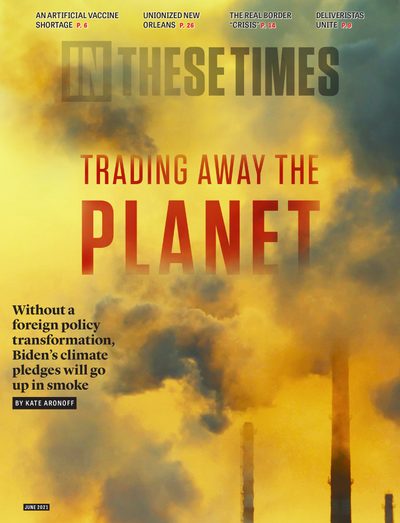There Is No "Border Crisis"
Discussing the border in nativist terms obscures the real crises that propel migrants to seek asylum in the United States.
Josue De Luna Navarro and Khury Petersen-Smith

U.S. Customs and Border Protection (CBP) temporarily closed the San Ysidro border crossing in San Diego on the morning of Nov. 19, 2018. With 100,000 people and 40,000 vehicles crossing each day, San Ysidro is one of the most heavily crossed land borders in the world — and CBP’s actions came during Monday morning rush hour.
Why? Because thousands of migrants, primarily from Central America, were heading north to seek asylum in the United States.
The freedom to move is an inalienable right, and applying for asylum at international borders is a legal right guaranteed by the U.N. Convention on Refugees (to which the United States is a signatory) and the U.S. Refugee Act. The Trump administration had known for weeks that these asylum seekers were coming, but instead of stationing additional officials to process their applications, it deployed the military and erected barriers.
Kirstjen Nielsen, former Homeland Security secretary, attempted to justify the closure by claiming the migrants wanted to rush the border to “gain illegal access to the U.S.” No evidence was presented and no such event came to pass that day. After three hours, most of the lanes reopened.
The resulting traffic jams and general disruption in the Tijuana-San Diego region did, however, feed into the right-wing narrative of a looming “invasion.” Less than a week later, U.S. agents fired tear gas across the border into a crowd of hungry and sick migrants in Tijuana, including children.
We should keep this story in mind as we hear about today’s crisis at the border. Because any crisis, real or invented, can inspire governments, police and armed forces to act with greater violence and impunity.
Just as in 2018, the recent increase in arrivals at the U.S.-Mexico border was predictable, this time based on seasonal migration and pent-up demand from pandemic border closures. But once again, instead of preparing enough beds and asylum officers, authorities chose cruelty and political theater.
Politico reports that, even before former President Donald Trump left office, his administration was planning to use the (again, completely predictable) migration increase to undermine the incoming administration of President Joe Biden.
Since Biden took office, rightwing outlets have run nonstop sensationalist border stories and congressional Republicans have indicated the border wall will be a centerpiece of the 2022 midterms. This response from conservatives is a tried-and-true tactic: distract attention from the very domestic problems they caused by labeling opponents as “soft” on security.
Sadly, the tactic also distracts from the very real plight of asylum seekers. Vulnerable families are trying to build better lives in the United States, and they could be garnering sympathy from much of the U.S. public, as evidenced by the waves of Keep Families Together rallies in 2018. Instead, the “border crisis” narrative casts these migrants as dangerous invaders who must be violently repelled.
It also obscures the U.S. foreign policy that drives migration. And it covers for an industry that profits from migrant detention and deportation.
The rhetoric has changed markedly under Biden, who frequently talks about the dignity and humanity of migrants at the border. But Biden’s actions have more in common with his predecessor than many may imagine.
Biden has reopened migrant youth detention centers that were closed in disgrace under Trump, and family separation — one of Trump’s most infamous policies — continues under Biden, albeit in different form. Families who arrive at the border are still denied entry, but unaccompanied minors pass through — tantamount to pushing the family separation problem down to the Mexico side of the border, rather than changing the policy.
Biden has continued to invoke Title 42, a public health statute first used by Trump to expel migrants under a cynical pretext of controlling Covid-19. And before movement outrage forced him to back down, Biden intended to maintain Trump’s historically low cap on refugees.
These realities reveal an institutionalized U.S. approach to immigration that is largely consistent across presidential administrations, rather than shaped by stark differences. Though both major political parties promote the idea that immigration will be vastly different depending on which holds power, immigration policies (and their enforcement) are shaped by ongoing bureaucracies and private industries.
Of course, differences between administrations do exist. Trump passed a Muslim travel ban, among a host of infamously cruel policies, for example. Still, he enforced them with a surveillance apparatus and a militarized border inherited from President Barack Obama (who deported more people than any other president, ever). And the Obama-era tools were forged under President George W. Bush, who put immigration under the purview of Homeland Security as he launched the War on Terror, which created new enforcement agencies and funding streams, and presented a boon to a private sector ready for government surveillance and incarceration contracts.
Today, the industries operating at the border do not seem worried about the Biden administration. These include the private detention companies, the companies that provide management and technical services (such as telephone and medical) for them, and the transportation companies that contract with CBP and Immigration and Customs Enforcement (ICE). In fact, according to the Transnational Institute, the CEOs and top employees of the top 13 companies in this “border-industrial complex” contributed three times more to Biden in 2020 — $5,364,994 — than to Trump.
The true crisis at the border is, arguably, the cruel and corrupt status quo that drives so many people to seek refuge.
There is the climate crisis, which produced devastating, back-to-back hurricanes in Central America in 2020. There is the dire economic situation (exacerbated to desperate levels by the pandemic), which has roots in the decades-long abuse by foreign corporations from the Global North destroying land and destabilizing local economies.
And there is the unbearable political and social instability caused by regressive regimes, which the United States arms, and which are more interested in industry than in the welfare of the people they govern. Decades of these policies have harmed generations of Central American people.
The manufactured, nativist version of the border crisis has also produced a new, real crisis: the thousands of adults and children in makeshift camps on the Mexico side of the border.
Trump all but openly designed policies to put people in this situation as a “deterrent” to immigration — which has failed, regardless, as people continue to come. Now, these people — exposed to the elements and to those looking to take advantage of them — are among the most vulnerable in the world.
So what is to be done? The policies and the forces that created the problem must be undone. We must prohibit profiteering from the persecution and incarceration of immigrants, defund ICE and CBP, and dispense with the conceit that we need a militarized, tightly controlled border across countries.
But as a first step, we must insist the U.S. government again recognize the right of migrants to apply for asylum, and honor its legal obligation to offer refuge. These migrants must be welcomed and cared for. Investing in an orderly, humane procedure for processing asylum applications will dismantle the manufactured border crisis and remove the teeth from the scaremongering about immigration, sustained by the border-industrial complex and the nativist Right.
Until we do, we should only expect this story to come up again, and again, and again.
Josue De Luna Navarro is cofounder of the New Mexico Dream Team and an associate fellow at IPS, researching immigration, climate and public health.
Khury Petersen-Smith is the Michael Ratner Middle East Fellow at the Institute for Policy Studies (IPS), researching U.S. empire, borders and migration.









